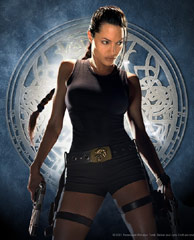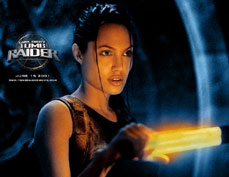| Tomb Raider |
| |
 |
UK/USA, 2001. Rated PG-13. 93 minutes.
Cast: Angelina Jolie, Iain Glen, Daniel
Craig, Noah Taylor, Chris Barrie, John Voigt, Leslie Phillips, Julian
Rhind-Tutt, Richard Johnson
Writers: Story by Mike Werb & Michael Colleary, screenplay by Patrick
Amssett & John Zinman, adaptation by Simon West
Music: Graeme Revell, Nine Inch Nails (song), U2 (song)
Cinematography: Peter Menzies Jr.
Producers: Lawrence Gordon, Lloyd Levin, Colin Wilson
Director: Simon West
LINKS
|
 t
was inevitable. The trend in summer movies is to fill them with more and more
action, so it was to be expected that, sooner or later, the story (i.e.,
that stuff that happens in between things exploding) would be crowded completely
out. Plot, schplot, we don't need no stinkin' plot! Is it really so important?
t
was inevitable. The trend in summer movies is to fill them with more and more
action, so it was to be expected that, sooner or later, the story (i.e.,
that stuff that happens in between things exploding) would be crowded completely
out. Plot, schplot, we don't need no stinkin' plot! Is it really so important?
Well, yes. Obviously, there have been plenty of entertaining action flicks
with disposable stories. But "disposable" implies there is some kind of story
present to begin with. In Tomb Raider, the story isn't disposable; it's
utterly absent. Plus, the characters are half-sketched, the action sequences
are tedious, and the style is undistinguished. It's fitting that Tomb Raider
is based on the popular videogame of the same name, because Tomb Raider
is--and I know I'm not the first reviewer to say this--no more interesting than
watching a video game.
With its impressive sets and photogenic, Academy Award-winning leading lady-with-an-attitude,
Tomb Raider seemingly has the basic ingredients for summer movie success.
But something went wrong at the laboratory. Someone messed up the formula, and
violated most action-movie rules in the process. Let's take a look at some of
those rules:
- The hero shall be a bad mofo. Audiences shall either desire the
hero, or desire to BE the hero.
In Lara Croft (Angeline Jolie), director Simon West and the brigade of generously
termed "writers" behind Tomb Raider certainly created a "bad mofo," but
they forgot to give her a personality. The heroine possesses the following--and
only the following--traits: 1) She is a tough gal; 2) She likes to live on the
edge; 3) She wears gun holsters on her thighs; 4) She has eccentrically large
lips; 5) She scorns the use of a sports bra, causing us to wonder at her ability
to kick major butt with all that bouncing around going on; 5) She keeps a knife
in her bed; 6) Her father is Jon Voigt. Hmmm… have I just described Lara Croft
or Angelina Jolie? Except for the English accent, Croft has no traits beyond
those we know the tabloid Jolie to possess.
JolieCroft bears no resemblance to an actual, or even an idealized, person.
This makes it difficult for us to sympathize with her, because to do so, we
need to know something about who she is and why she is who she is. We are told
in a vague way that JolieCroft misses her dearly departed father, and during
scenes involving her father or his memory, JolieCroft even treats us to an expression
change. Despite that, we know nothing about our heroine, nor do we know anything
about her butler and her technical assistant. Who are they? Why are they so
devoted to JolieCroft? We don't know. They just… are.
Second action-movie rule:
- The villain shall be an even badder mofo.
Action movies thrive on great villains. The villain should be a lascivious
personification of evil. The villain should be skilled or terrifying enough
to represent a believable threat to the hero, so that the outcome appears to
be in doubt. Though we know the hero will win, the movie must make us forget
that this is so.
Tomb Raider, however, spends no time establishing its villains, none
of whom seem particularly capable or terrifying. All the bad guys work for a
secret society called "The Illuminati." The name sounds suitably ominous. Many
of us have heard of this society and heard the legend that the eye atop the
pyramid on the one-dollar bill is its symbol. But in Tomb Raider, Illuminati
is just a meaningless name thrown around for effect. We are not told what the
organization represents, other than Something Nefarious. They could just as
well have called it the American Whig Party.
The Illuminati retain the services of another "tomb raider" named Alex Marrs
(Daniel Craig), whom the movie suggests is an ex-lover of JolieCroft. Again,
we are told nothing about him; therefore, a scene in which there is supposed
to be sexual tension between West and JolieCroft falls flat on its face. Similarly,
later in the film, when JolieCroft must save Marrs' life, we are mystified as
to why she bothers.
Action-movie rule number three:
- Even if the Evil Plan makes as much sense as U.S. electoral law,
the stakes and the hero's purpose shall be clear.
James Bond movies proved that the Evil Plan doesn't need to be comprehensible.
However, the result of the Evil Plan should be, so the audience knows what is
at stake. In Tomb Raider, the Illuminati propose to retrieve and reassemble
an ancient relic that, when combined with an astronomically impossible full
planetary alignment that supposedly occurs once every five thousand years (but
actually occurs never), will give them mastery over time, or something, which
will enable them to do Dreadfully Nefarious Things. Basically we're talking
about the same deal as in the Indiana Jones and The
Mummy movies, but it's far less fleshed out.
As for JolieCroft, her goals are a muddle. She, at first, fights the villains
for part of the ancient relic, then gives up her hard-won prize and pretends
to forge an alliance with them as they search for the rest of it, even though
all she needs to do to stop them is throw her piece of the relic into the ocean.
End of story. But I suppose that would be way too logical. 
Action-movie rule the fourth:
- The action shall kick ass.
It's hard to say whether the action is well choreographed or conceived, because
the camerawork is too tight and the editing too quick to be able to follow the
action clearly. They say that JolieCroft performed many of her own stunts, but
with all the rapid cuts, she needn't have. We wouldn't have been able to tell
the difference.
Fifth rule of a successful action movie:
- The effects shall be impressive.
Are the CG monsters in a computer game scary? No. Neither are the monsters
in Tomb Raider. JolieCroft fights CG creatures and robots that are obviously
fake. Giant cartoon monsters made of stone that fall apart if you when hit them
with a sword or a few bullets, which, realistically, should have no effect on
a stone monster… yeah, that's impressive.
Last, but not least, the sixth rule of a popcorn action movie:
- There shall be groovy one-liners.
Perhaps the thing that falls flattest is Tomb Raider's sense of humor.
Tomb Raider confuses swagger with fun. All the one liners (expect one,
addressed to a deliveryman) consist of JolieCroft expressing relish at the thought
of butt-kicking. They misfire, and the half-hearted attempts at action-movie
banter are no better.
Having subverted the successful formula by violating every one of these cardinal
rules and countless more, Tomb Raider is big, loud, and unrelentingly
dull. Just because formula is formula, doesn't mean it can't work. I rated Swordfish,
which is basically a moronic film, a C+. I gave Mortal
Kombat, another film based on a video game, the same grade. Mortal
Kombat gets a mild thumbs-up while Tomb Raider is trashed because
Mortal Kombat was up-front about its own absurdity (and thus more genuinely
funny). It had better pacing and a better soundtrack, and CGs were still a novelty
six years ago. It's strange that a movie like Pearl
Harbor can make it seem that CGs have evolved a great deal since Mortal
Kombat, but a movie like Tomb Raider makes it appear as if they haven't
progressed at all.
I'm sure the game upon which this film is based is great fun to play. However,
in a video game, if one turn is a complete disaster, you can start again, hoping
for greater success. As the local cineplex comes with no Reset button to ease
your pain, the brain trust that decided to raid this mouldering tomb should
have let it rest in peace.
Review
© June 2001 by AboutFilm.Com and the author.
Images © 2001 Paramount Pictures. Tomb Raider and Lara Croft are trademarks
of Core Design Ltd. All Rights Reserved.


